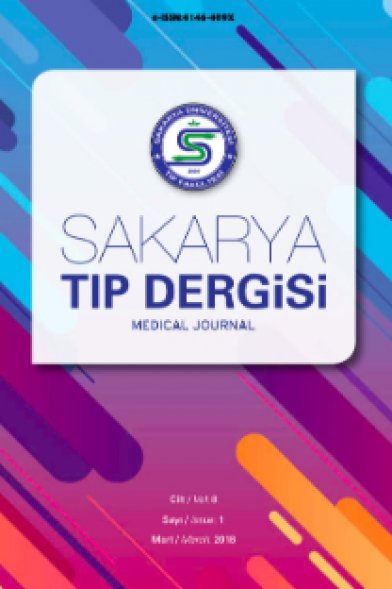Lokal İleri Evre Baş Boyun Kanseri Tanısı ile Organ Koruyucu Tedavi Protokolü Olarak Kemoradyoterapi Uygulanan Hastalarda Tedavi Yanıtının ve Sağkalımın Değerlendirilmesi
Assessment of Treatment Response and Survival in Patients Diagnosed with Locally Advanced Head and Neck Cancer Treated with Chemoradiotherapy As Part of An Organ-Preservation Treatment Protocol
___
- 1. Jemal A, Murray T, Samuels A, Ghafoor A, Ward E, Th un MJ. Cancer statistics, 2003. CA Cancer J Clin 2003;53:5-26.
- 2. Jemal A, Siegel R, Xu J, Ward E. Cancer statistics, 2010. CA Cancer J Clin 2010;60:277-300.
- 3. Lefebvre JL, Chevalier D, Luboinski B, Kirkpatrick A, Collette L, Sahmoud T. Larynx preservation in pyriform sinus cancer: preliminary results of a European Organization for Research and Treatment of Cancer phase III trial. EORTC Head and Neck Cancer Cooperative Group J Natl Cancer Inst 1996;88:890-9.
- 4. The Department of Veterans Aff airs Laryngeal Cancer Study Group. Induction chemotherapy plus radiation compared with surgery plus radiation in patients with advanced laryngeal cancer. N Engl J Med 1991;324:1685-90.
- 5. Edge SB, Byrd DR, Compton CC, Fritz AG, Greene FL, Trotti A, editors. AJCC cancer staging manual 7th ed. New York, NY: Springer, 2010.
- 6. Forastiere A, Koch W, Trotti A, Sidransky D. Head and neck cancer. N Engl J Med 2001;345:1890-900.
- 7. Posner MR, Haddad RI, Wirth L, Norris CM, Goguen LA, Mahadevan A, et al. Induction chemotherapy in locally advanced squamous cell cancer of the head and neck: evolution of the sequential treatment approach. Semin Oncol 2004;31:778-85.
- 8. Agrawal N, Ha PK. Management of early-stage laryngeal cancer. Otolaryngol Clin North Am 2008;41:757-69.
- 9. Scher RL, Esclamado RM. Organ and function preservation: the role of surgery as the optimal primary modality or as salvage aft er chemoradiation failure. Semin Radiat Oncol 2009;19:17-23.
- 10. Pignon JP, le Maître A, Bourhis J, MACH-NC Collaborative Group. Meta-analyses of chemotherapy in head and neck cancer (MACH-NC): an update. Int J Radiat Oncol Biol Phys 2007;69:112-4.
- 11. Garden AS, Asper JA, Morrison WH, Schechter NR, Glisson BS, Kies MS, et al. Is concurrent chemoradiation the treatment of choice for all patients with Stage III or IV head and neck carcinoma? Cancer 2004;100:1171-8.
- 12. Brizel DM, Albers ME, Fisher SR, Scher RL, Richtsmeier WJ, Hars V, et al. Hyperfractionated irradiation with or without concurrent chemotherapy for locally advanced head and neck cancer. N Engl J Med 1998;338:1798-804.
- 13. Cruz JJ, Ocaña A, Navarro M, Barco ED, Fonseca E. New options in the treatment of locally advanced head and neck cancer: role for induction chemotherapy. Cancer Treat Rev 2008;34:268-74.
- 14. Forastiere AA, Goepfert H, Maor M, Pajak TF, Weber R, Morrison W, et al. Concurrent chemotherapy and radiotherapy for organ preservation in advanced laryngeal cancer. N Engl J Med 2003;349:2091-8.
- 15. Medina JA, Rueda A, de Pasos AS, Contreras J, Cobo M, Moreno P, et al. A phase II study of concomitant boast radiation plus concurrent weekly cisplatin for locally advanced unresectable head and neck carcinomas. Radiother Oncol 2006;79:34-38.
- 16. Blanchard P, Baujat B, Holostenco V, Bourredjem A, Baey C, Bourhis J, et al. Meta-analysis of chemotherapy in head and neck cancer (MACH-NC): a comprehensive analysis by tumour site. Radiother Oncol 2011;100:33-40.
- 17. Vermorken JB, Remenar E, van Herpen C, et al. Cisplatin, fl uorouracil, and docetaxel in unresectable head and neck cancer. N Engl J Med 2007; 357: 1695-704
- 18. Posner MR, Hershock DM, Blajman CR, et al. Cisplatin and fl uorouracil alone or with docetaxel in head and neck cancer. N Engl J Med 2007; 357: 1705-15
- 19. Pointreau Y, Garaud P, Chapet S, et al. Randomized trial of induction chemotherapy with cisplatin and 5-fl uorouracil with or without docetaxel for larynx preservation. J Natl Cancer Inst 2009; 101: 498-506.
- 20. Lefebvre JL, Pointreau Y, Rolland F et al. Induction chemotherapy followed by either chemoradiotherapy or bioradiotherapy for larynx preservation: the TREMPLIN randomized phase II study. J Clin Oncol 2013; 31(7): 853-859.
- 21. Dietz A, Wichmann G, Kuhnt T, Pfreundner L, Hagen R, Scheich M, et al. Induction chemotherapy (IC) followed by radiotherapy (RT) versus cetuximab plus IC and RT in advanced laryngeal/hypopharyngeal cancer resectable only by total laryngectomy-final results of the larynx organ preservation trial DeLOS=II Ann Oncol. 2018 29:2105-14.
- Yayın Aralığı: 4
- Başlangıç: 2011
- Yayıncı: Sakarya Üniversitesi
Gadolinuma Bağlı Akut Böbrek Hasarı: Bir Olgu Sunumu
Hamad DHEİR, Serap ÜNGAN, Ahmed Bilal GENÇ, Necattin FİRAT, Selcuk YAYLACI, Savaş SİPAHİ
Sertolizumab Tedavisine Sekonder Demiyelizan Hastalık Geçiren Bir Vaka
Medyada Yer Alan Kanser Haberlerinin Değerlendirilmesi
Ufuk Berberoğlu, Abdülkadir Aydın, Gürkan Muratdağı, Fulya Aktan Kibar, Gökhan Oturak, Hasan Çetin Ekerbiçer, Neşe Aşıcı, Mine Keskin
Paroksismal Atrial Fibrilasyonlu Hastalarda Strokun Transözefagial Ekokardiyografik Prediktörleri
Tarık YILDIRIM, Eyüp AVCI, Fatih AKIN, Seda Elçim YILDIRIM, İbrahim ALTUN, Mustafa Özcan SOYLU
Hemoptizi Yakınması ile Başvuran Hastalarda Etiyolojik Değerlendirme
Mustafa ÇOLAK, Mehmet Ali ASLANER
Gökhan ARICAN, Hacer UĞURLU, Burak KÜÇÜK, Murat ARAL, Gürkan MURATDAĞI
Yalçın HACIOĞLU, Nurten BAHTİYAR
Akut Kolesistit ile Başvuran Atipik Bruselloz Olgusu
Sevil ALKAN ÇEVİKER, Habibe Tülin ELMASLAR MERT, Mehmet Ali GEDİK
Tüberküloz ve D Vitamini Arasındaki İlişkinin Değerlendirilmesi: Güncel Yaklaşımlar
